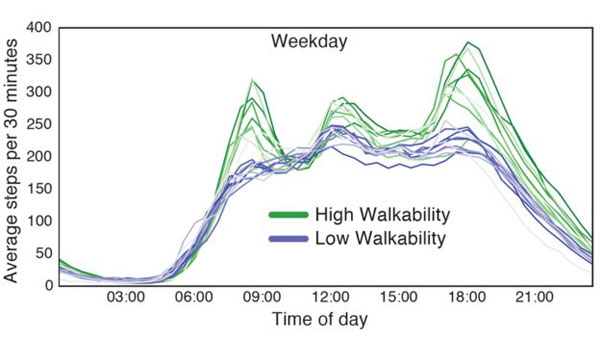当前位置: Language Tips> 双语新闻
Do you live in the world's laziest country?
美国斯坦福大学的研究人员分析了111个国家的71.7万名居民的智能手机信息,以弄清他们当中的某个人每天要走多少路。分析结果显示,印尼人最懒,他们每天只走3513步。

US scientists have amassed "planetary-scale" data from people's smartphones to see how active we really are.
美国的科学家们从人们的智能手机中收集了海量数据,用来研究人们的实际活动情况。
The Stanford University analysis of 68 million days' worth of minute-by-minute data showed the average number of daily steps was 4,961.
斯坦福大学对精确到分钟、总时长相当于6800天的数据进行分析后发现,世界各地的人们平均每天走路4961步。
China was top averaging more than 6,000 a day, while Indonesia was bottom of the rankings with just 3,513.
中国人平均每天走6000多步,排名居首,而印度尼西亚人平均每天走3513步,在排名中垫底。
But the findings also uncovered intriguing details that could help tackle obesity.
研究结果还揭露了一些有趣的细节,有助于我们对抗肥胖。
Most smartphones have a built-in accelerometer that can record steps and the researchers used anonymous data from more than 700,000 people who used the Argus activity monitoring app.
大多数智能手机都有内置的加速计,可以记录行走步数,研究者们还使用了70多万人在活动监测软件Argus上的匿名数据。
Scott Delp, a professor of bioengineering and one of the researchers, said: "The study is 1,000 times larger than any previous study on human movement.
参与此项研究的生物工程教授斯科特•德尔普说:“这项研究比以往任何一项关于人类运动的研究在规模上都要大上1000倍。”

Activity inequality
活动不均等
The findings have been published in the journal Nature and the study authors say the results give important insights for improving people's health.
研究结果发表在《自然》杂志上,作者们认为研究结果在改善人类健康方面有重大启示。
The average number of steps in a country appears to be less important for obesity levels, for example.
比如,一个国家的平均走路步数对肥胖水平来说似乎没有那么重要。
The key ingredient was "activity inequality" - it's like wealth inequality, except instead of the difference between rich and poor, it's the difference between the fittest and laziest.
关键的因素是“活动不均等”,就像财富不均等一样,只是活动不均等指的是最健康和最懒的人之间的差距,而非富人和穷人间的差距。
The bigger the activity inequality, the higher the rates of obesity.
活动越不均等,肥胖的比例就越高。
Tim Althoff, one of the researchers, said: "For instance, Sweden had one of the smallest gaps between activity rich and activity poor... it also had one of the lowest rates of obesity."
研究者蒂姆•阿尔托夫表示:“举例来说,瑞典爱运动和不爱运动的人之间的差距最小……同时也是肥胖率最低的国家之一。”
The United States and Mexico both have similar average steps, but the US has higher activity inequality and obesity levels.
美国和墨西哥平均走路步数相似,但美国活动不均等的程度和肥胖率都更高。
The researchers were surprised that activity inequality was largely driven by differences between men and women.
研究者还惊讶地发现,活动不均等的程度与男女差异有很大的关联。
In countries like Japan - with low obesity and low inequality - men and women exercised to similar degrees.
比如,日本的肥胖率和活动不均等程度都较低,男性和女性锻炼的频率接近。
But in countries with high inequality, like the US and Saudi Arabia, it was women spending less time being active.
而在美国和沙特阿拉伯这些活动不均等程度较高的国家,女性往往花更少时间锻炼。
Jure Leskovec, also part of the research team, said: "When activity inequality is greatest, women's activity is reduced much more dramatically than men's activity, and thus the negative connections to obesity can affect women more greatly."
研究者卓尔•莱斯科夫认为:“当活动不均等最严重的时候,女性锻炼比男性要少得多,因此女性受到肥胖的影响要比男性更大。”
The Stanford team say the findings help explain global patterns of obesity and give new ideas for tackling it.
斯坦福大学的研究小组认为,研究结果还有助于解释全球的肥胖类型,并对控制肥胖给予了新的启发。
For example, they rated 69 US cities for how easy they were to get about on foot.
比如,他们根据人们步行的便利性对美国69个城市进行排序。
The smartphone data showed that cities like New York and San Francisco were pedestrian friendly and had "high walkability".
智能手机的数据表明,纽约和旧金山等城市对步行者更友好,步行率也更高。

Whereas you really need a car to get around "low walkability" cities including Houston and Memphis.
然而在休斯敦、孟菲斯等步行率较低的城市,你的确需要一辆车才能出行。
Unsurprisingly, people walked more in places where it was easier to walk.
毫无疑问,在适合走路的区域,人们会愿意走路去更多地方。
The researchers say this could help design town and cities that promote greater physical activity.
研究者认为这将有助于城镇和城市规划,促使人们更多地锻炼。
英文来源:BBC
翻译:刘子豪(中国日报网爱新闻iNews译者)
编审:yaning
上一篇 : 《权游》首集黄老板现身
下一篇 :
关注和订阅

电话:8610-84883645
传真:8610-84883500
Email: languagetips@chinadaily.com.cn